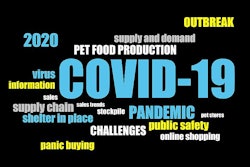
Among other correlations between eight factors and canine obesity rates, researchers identified lower dog obesity prevalence among dogs whose owners’ reported feeding of probiotics or fresh dog food. Dogs eating dry food or kibble tended to have higher obesity rates than those eating fresh dog foods, in the pre-peer-reviewed study posted on bioRxiv.
Researchers with Nom Nom, a fresh, direct-to-consumer pet food brand, collected body condition scores, demographic, diet and lifestyle data on 4,446 dogs. Of these, dog owners reported that 1,480 (33%) of dogs were overweight or obese with 356 (8% total) of dogs scored as obese.
“Fresh pet food includes commercial fresh food, commercial frozen food and home-cooked food,” LeeAnn Perry, study leader and NomNomNow bioinformatics analyst, said. “These types of pet food are typically characterized by the usage of whole foods ingredients that are gently cooked or minimally processed prior to being frozen or refrigerated… Of the 4,446 dogs in our study, 22% were currently being fed fresh food only, and an additional 17% were being fed fresh food in combination with other types of food.”
Eight factors associated with overweightness or obesity, and obesity alone in the research:
- diet composition,
- probiotic supplementation,
- treat quantity,
- exercise,
- age,
- food motivation level,
- pet appetite and
- neutering
Pet owner education to avoid obesity
While various factors play into dog obesity, and many can't be influenced by pet food companies, brands can educate consumers about some influences on pet obesity.
“Different dogs have different needs, so personalization is key,” Perry said. “Instead of one-size-fits-all advice, pet food companies should produce customized education materials based on different demographic and lifestyle factors. Furthermore, pet food companies have a responsibility to their consumers to derive these recommendations from scientifically-backed, data-driven findings.
“One finding of our study was that treats are a risk factor for obesity when they make up over 10% of a dog's caloric intake, but not when consumed in moderation. Pet food companies that produce treats should help owners understand best treat-feeding practices, ranging from how, when, and what to treat. One potential avenue for this education outside of appropriate packaging is social media which allows for significant engagement with customers, even for those manufacturers that do not sell directly to consumers.”
Beyond the results of this research, Perry said pet food companies can contribute to scientific efforts by sharing data.
“We hope that our retrospective data, which we constantly collect, shows that pet food companies can and should provide scientific information from direct engagement with customers,” she said. “In doing so, collectively the industry can help suggest areas for future study that can lead to additional data-driven nutritional solutions for our pets.”

















